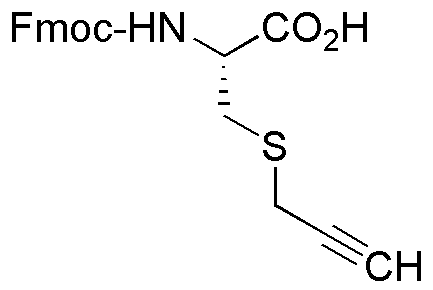(R)-Fmoc-2-amino-3-propargylsulfanyl-propionic acid is widely utilized in research focused on:
- Peptide Synthesis: This compound serves as a key building block in the synthesis of peptides, particularly in solid-phase peptide synthesis, allowing for the creation of complex peptide structures with enhanced stability.
- Drug Development: Its unique properties make it valuable in the pharmaceutical industry for developing new drugs, especially those targeting specific biological pathways, due to its ability to modify peptide sequences effectively.
- Bioconjugation: The compound can be used in bioconjugation techniques, facilitating the attachment of biomolecules to surfaces or other molecules, which is essential in creating targeted therapies and diagnostics.
- Research in Neuroscience: It plays a role in studying neuropeptides and their functions, providing insights into neurological disorders and potential therapeutic approaches.
- Material Science: The compound can be incorporated into polymer matrices, enhancing the properties of materials used in drug delivery systems, thereby improving the efficacy and control of drug release.
General Information
Properties
Safety and Regulations
Applications
(R)-Fmoc-2-amino-3-propargylsulfanyl-propionic acid is widely utilized in research focused on:
- Peptide Synthesis: This compound serves as a key building block in the synthesis of peptides, particularly in solid-phase peptide synthesis, allowing for the creation of complex peptide structures with enhanced stability.
- Drug Development: Its unique properties make it valuable in the pharmaceutical industry for developing new drugs, especially those targeting specific biological pathways, due to its ability to modify peptide sequences effectively.
- Bioconjugation: The compound can be used in bioconjugation techniques, facilitating the attachment of biomolecules to surfaces or other molecules, which is essential in creating targeted therapies and diagnostics.
- Research in Neuroscience: It plays a role in studying neuropeptides and their functions, providing insights into neurological disorders and potential therapeutic approaches.
- Material Science: The compound can be incorporated into polymer matrices, enhancing the properties of materials used in drug delivery systems, thereby improving the efficacy and control of drug release.
Documents
Safety Data Sheets (SDS)
The SDS provides comprehensive safety information on handling, storage, and disposal of the product.
Product Specification (PS)
The PS provides a comprehensive breakdown of the product’s properties, including chemical composition, physical state, purity, and storage requirements. It also details acceptable quality ranges and the product's intended applications.
Certificates of Analysis (COA)
Search for Certificates of Analysis (COA) by entering the products Lot Number. Lot and Batch Numbers can be found on a product’s label following the words ‘Lot’ or ‘Batch’.
Numéro de catalogue
Numéro de lot/série
Certificates Of Origin (COO)
This COO confirms the country where the product was manufactured, and also details the materials and components used in it and whether it is derived from natural, synthetic, or other specific sources. This certificate may be required for customs, trade, and regulatory compliance.
Numéro de catalogue
Numéro de lot/série
Safety Data Sheets (SDS)
The SDS provides comprehensive safety information on handling, storage, and disposal of the product.
DownloadProduct Specification (PS)
The PS provides a comprehensive breakdown of the product’s properties, including chemical composition, physical state, purity, and storage requirements. It also details acceptable quality ranges and the product's intended applications.
DownloadCertificates of Analysis (COA)
Search for Certificates of Analysis (COA) by entering the products Lot Number. Lot and Batch Numbers can be found on a product’s label following the words ‘Lot’ or ‘Batch’.
Numéro de catalogue
Numéro de lot/série
Certificates Of Origin (COO)
This COO confirms the country where the product was manufactured, and also details the materials and components used in it and whether it is derived from natural, synthetic, or other specific sources. This certificate may be required for customs, trade, and regulatory compliance.


